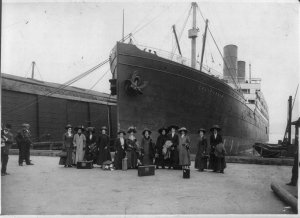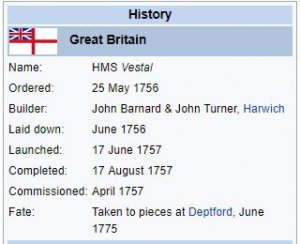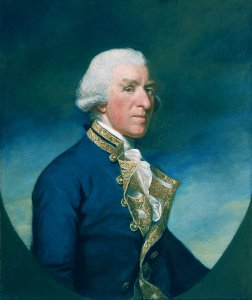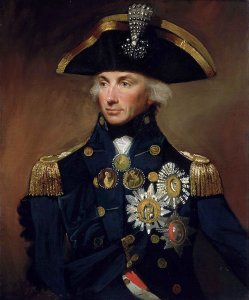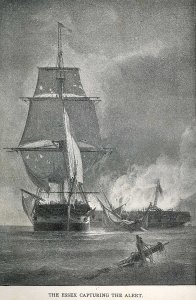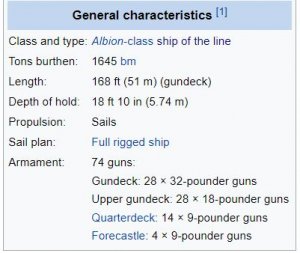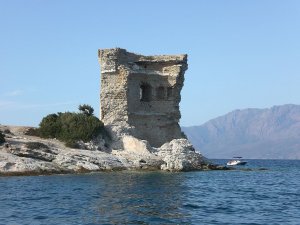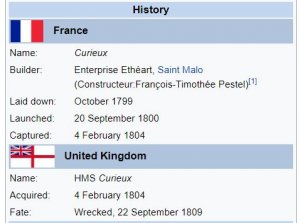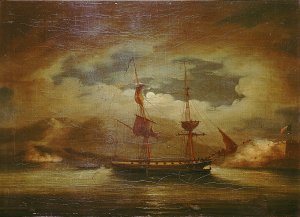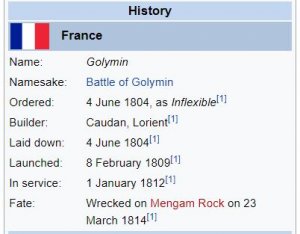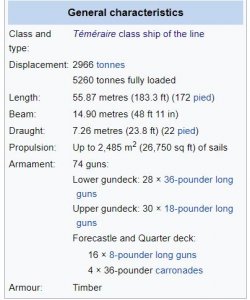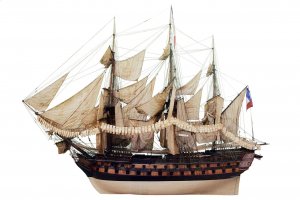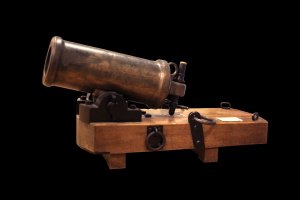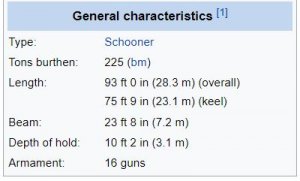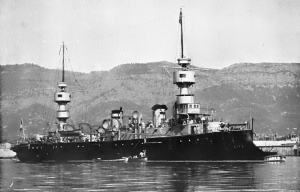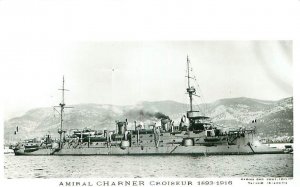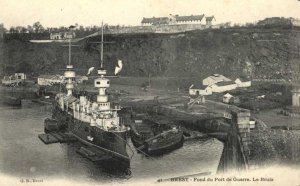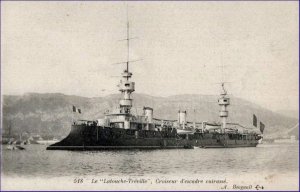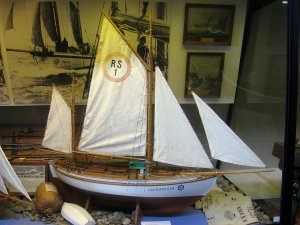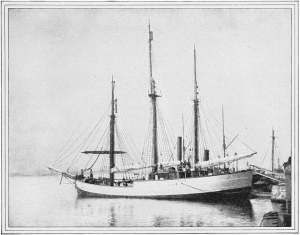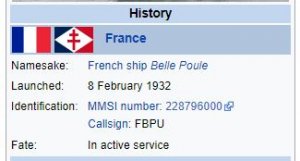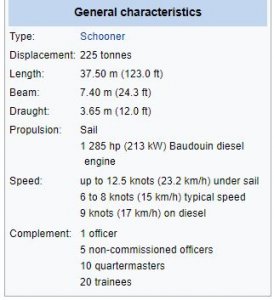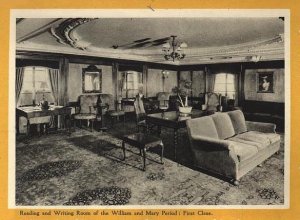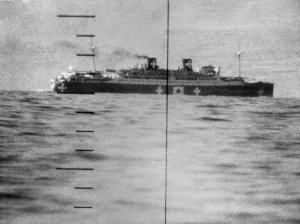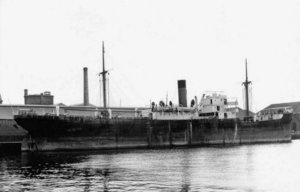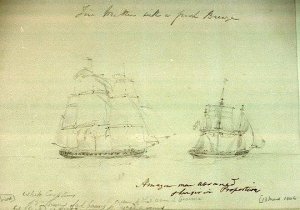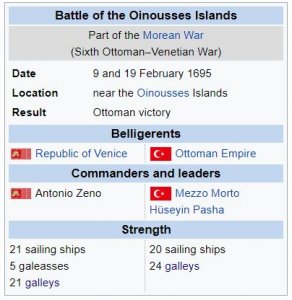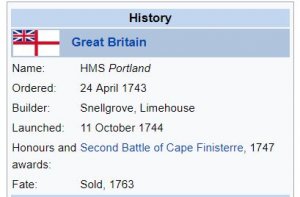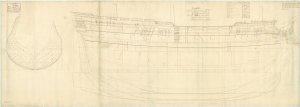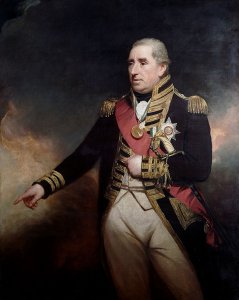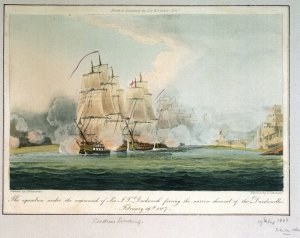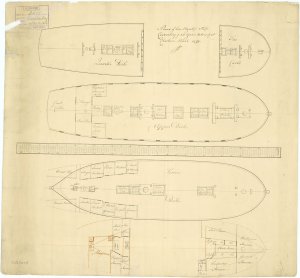Today in Naval History - Naval / Maritime Events in History
7 February 1866 - Naval Battle of Abtao
The Battle of Abtao was a naval battle fought on February 7, 1866, during the Chincha Islands War, between a Spanish squadron and a combined Peruvian-Chilean fleet, at the island of Abtao in the Gulf of Ancud near Chiloé Archipelago in south-central Chile. It reduced to a long-range exchange of fire between the two squadrons, as the Allied ships, anchored behind the island, were protected by shallow waters impracticable for the Spanish ships, whose gunnery, nevertheless, proved more accurate and inflicted damage to the Chilean and Peruvian ships.
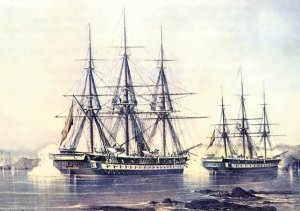
Spanish screw frigates Blanca and Villa de Madridduring battle, by Federico Castellón Martínez. Naval Museum of Madrid
Background
Sent by Peruvian president Mariano Ignacio Prado, who had rallied the South Americans in defense against Spanish aggression, the allies had sailed in convoy from the town of Ancud to the island of Abtao to wait for the arrival of two new corvettes acquired by Peru.
The Spanish commander Casto Méndez Núñez, informed about the location of the Peruvian-Chilean fleet, ordered that the steam frigates Villa de Madrid (Captain Claudio Alvar González) and Reina Blanca(Commander Juan Topete), lift the blockade on Valparaiso and sail towards Abtao to intercept the enemy fleet.
On January 16, 1866, the combined Peruvian-Chilean fleet, composed of the Peruvian frigates Apurímac and Amazonas and the recently captured and refurbished Chilean schooner Covadonga, had convoyed from the port of Ancud towards the shipyards on the little island of Abtao, at the head of the southern Chiloé Archipelago. On Abtao island, the Chileans had also built some military fortifications, which were strategically located at the end of a shallow and treacherous channel.
During the difficult trip, the 36-gun steam frigate Amazonas, suffering from the force of currents, collided with a submerged rock near Punta Quilque and sank. The rest of the allied ships arrived without problems, and remained in Abtao with orders to wait for the arrival of the Peruvian corvettes Unión and América in order to start the offensive against the Spanish force. These ships arrived on February 4, 1866 without being detected by the enemy ships.
Meanwhile, the Spanish force was informed by the aborigines about the presence of other ships near Abtao, and immediately set course to the island.

Battle
The frigates Villa de Madrid and Reina Blanca appeared off the inlet of Abtao on February 7, 1866, but did not enter, for fear of the shallow waters.
Manuel Villar, Commander of the Peruvian First Naval Division and commander of the combined fleet, ordered the attack when the Spaniards began to proceed through the widest channel. The allied ships (which included Apurímac, América, Unión, and Covadonga) formed a line of battle to cover both inlets of the channel with their artillery.
The Allied fleet opened fire at 15:30 hours from 1500 meters, followed by fire of the Spanish fleet, which showed great accuracy despite the two frigates being forced to shoot alternately due to the position of the Allied fleet. The Apurímac was hit three times at the water line, forcing her to move north. The América was hit six times. The Unión, where two crewman were killed, was hit three times, and the Covadonga, one. The Spanish ships received fourteen hits, mainly by the América and the Unión, which caused only little damage and left 6 crewmen wounded.
After two hours of battle and more of 1500 shots from each side, the Spanish frigates, seeing that the Allied fleet was well protected in her position around the shoals, decided to leave the reef and waited to go out to sea. But this did not happen, and at 9:00 am of the following day, the Spanish squadron returned to their base.
In his report to the Admiral Méndez Nuñez, the Spanish Captain Claudio Alvar González wrote:

In the ongoing conflict between Spain and the Peru-Chile alliance in the Chincha Islands War, two Spanish warships, Villa de Madrid and Blanca, sought to engage Chilean-Peruvian naval units and avenge earlier Spanish naval defeats. Attacking four enemy vessels in the narrow straits off the Chilean port of Abtao, the Spanish ships inflicted damage and casualties from a distance but could not follow up in water unsuitable for their larger vessels. (By John Osborne)
Aftermath
After the results of the battle of Abtao, the Rear Admiral Casto Méndez Núñez traveled south with the Numancia, Resolución and Reina Blanca to try to force a new confrontation with the allies. But his efforts were unsuccessful. The Allied fleet had moved to Huito, a position much more difficult to access than Abtao.
On March 25, the Peruvian corvettes Unión and América were sent to the Strait of Magellan to intercept the Spanish frigate Almansa, that according to intelligence reports, had been dispatched from Spain to reinforce the Pacific fleet. The Peruvian ships remained in the area for over a month, but were not able to locate it. The Almansa didn't arrive to the Pacific coast until the end of April. The Chilean government also sent steamer Maipú to the strait to intercept the Spanish steamers Odessa and Vascongada.
The rest of the Allied fleet remained on the defensive in southern Chile, awaiting the arrival of the ironclads Huáscar and Independencia, destined to become the factor that would change the force equilibrium. Both ships had departed from Brest on 26 February, in what was a long and difficult journey. They were accompanied by the British Steamer Thames, which transported coal and other provisions. On 30 March 1866, in front of Brazilian waters, the Peruvian ironclads caused new problems for the Spaniards by intercepting the bergantines Dorotea and Paco. The Dorotea was destroyed, while the Paco was able to avoid capture by moving quickly. On 22 August 1866 the Spanish frigate Gerona captured the Chilean schooner Pampero when it set sail from the jetty of Funchal to Chile.
Notable sailors in the battle
Sub-lieutenant Patricio Montojo y Pasarón, later to become an Admiral and commander-in-chief of the Spanish Navy in the Philippines during the Spanish–American War, participated in this battle from the frigate Almansa.
Lieutenants Arturo Prat (Chilean) and Miguel Grau (Peruvian), who were later to battle each other at the Naval Battle of Iquique, were comrades in this battle.
http://en.wikipedia.org/wiki/Battle_of_Abtao
7 February 1866 - Naval Battle of Abtao
The Battle of Abtao was a naval battle fought on February 7, 1866, during the Chincha Islands War, between a Spanish squadron and a combined Peruvian-Chilean fleet, at the island of Abtao in the Gulf of Ancud near Chiloé Archipelago in south-central Chile. It reduced to a long-range exchange of fire between the two squadrons, as the Allied ships, anchored behind the island, were protected by shallow waters impracticable for the Spanish ships, whose gunnery, nevertheless, proved more accurate and inflicted damage to the Chilean and Peruvian ships.

Spanish screw frigates Blanca and Villa de Madridduring battle, by Federico Castellón Martínez. Naval Museum of Madrid
Background
Sent by Peruvian president Mariano Ignacio Prado, who had rallied the South Americans in defense against Spanish aggression, the allies had sailed in convoy from the town of Ancud to the island of Abtao to wait for the arrival of two new corvettes acquired by Peru.
The Spanish commander Casto Méndez Núñez, informed about the location of the Peruvian-Chilean fleet, ordered that the steam frigates Villa de Madrid (Captain Claudio Alvar González) and Reina Blanca(Commander Juan Topete), lift the blockade on Valparaiso and sail towards Abtao to intercept the enemy fleet.
On January 16, 1866, the combined Peruvian-Chilean fleet, composed of the Peruvian frigates Apurímac and Amazonas and the recently captured and refurbished Chilean schooner Covadonga, had convoyed from the port of Ancud towards the shipyards on the little island of Abtao, at the head of the southern Chiloé Archipelago. On Abtao island, the Chileans had also built some military fortifications, which were strategically located at the end of a shallow and treacherous channel.
During the difficult trip, the 36-gun steam frigate Amazonas, suffering from the force of currents, collided with a submerged rock near Punta Quilque and sank. The rest of the allied ships arrived without problems, and remained in Abtao with orders to wait for the arrival of the Peruvian corvettes Unión and América in order to start the offensive against the Spanish force. These ships arrived on February 4, 1866 without being detected by the enemy ships.
Meanwhile, the Spanish force was informed by the aborigines about the presence of other ships near Abtao, and immediately set course to the island.

Battle
The frigates Villa de Madrid and Reina Blanca appeared off the inlet of Abtao on February 7, 1866, but did not enter, for fear of the shallow waters.
Manuel Villar, Commander of the Peruvian First Naval Division and commander of the combined fleet, ordered the attack when the Spaniards began to proceed through the widest channel. The allied ships (which included Apurímac, América, Unión, and Covadonga) formed a line of battle to cover both inlets of the channel with their artillery.
The Allied fleet opened fire at 15:30 hours from 1500 meters, followed by fire of the Spanish fleet, which showed great accuracy despite the two frigates being forced to shoot alternately due to the position of the Allied fleet. The Apurímac was hit three times at the water line, forcing her to move north. The América was hit six times. The Unión, where two crewman were killed, was hit three times, and the Covadonga, one. The Spanish ships received fourteen hits, mainly by the América and the Unión, which caused only little damage and left 6 crewmen wounded.
After two hours of battle and more of 1500 shots from each side, the Spanish frigates, seeing that the Allied fleet was well protected in her position around the shoals, decided to leave the reef and waited to go out to sea. But this did not happen, and at 9:00 am of the following day, the Spanish squadron returned to their base.
In his report to the Admiral Méndez Nuñez, the Spanish Captain Claudio Alvar González wrote:
The most effective and precise shots came from the Peruvian corvettes Unión and América.

In the ongoing conflict between Spain and the Peru-Chile alliance in the Chincha Islands War, two Spanish warships, Villa de Madrid and Blanca, sought to engage Chilean-Peruvian naval units and avenge earlier Spanish naval defeats. Attacking four enemy vessels in the narrow straits off the Chilean port of Abtao, the Spanish ships inflicted damage and casualties from a distance but could not follow up in water unsuitable for their larger vessels. (By John Osborne)
Aftermath
After the results of the battle of Abtao, the Rear Admiral Casto Méndez Núñez traveled south with the Numancia, Resolución and Reina Blanca to try to force a new confrontation with the allies. But his efforts were unsuccessful. The Allied fleet had moved to Huito, a position much more difficult to access than Abtao.
On March 25, the Peruvian corvettes Unión and América were sent to the Strait of Magellan to intercept the Spanish frigate Almansa, that according to intelligence reports, had been dispatched from Spain to reinforce the Pacific fleet. The Peruvian ships remained in the area for over a month, but were not able to locate it. The Almansa didn't arrive to the Pacific coast until the end of April. The Chilean government also sent steamer Maipú to the strait to intercept the Spanish steamers Odessa and Vascongada.
The rest of the Allied fleet remained on the defensive in southern Chile, awaiting the arrival of the ironclads Huáscar and Independencia, destined to become the factor that would change the force equilibrium. Both ships had departed from Brest on 26 February, in what was a long and difficult journey. They were accompanied by the British Steamer Thames, which transported coal and other provisions. On 30 March 1866, in front of Brazilian waters, the Peruvian ironclads caused new problems for the Spaniards by intercepting the bergantines Dorotea and Paco. The Dorotea was destroyed, while the Paco was able to avoid capture by moving quickly. On 22 August 1866 the Spanish frigate Gerona captured the Chilean schooner Pampero when it set sail from the jetty of Funchal to Chile.
Notable sailors in the battle
Sub-lieutenant Patricio Montojo y Pasarón, later to become an Admiral and commander-in-chief of the Spanish Navy in the Philippines during the Spanish–American War, participated in this battle from the frigate Almansa.
Lieutenants Arturo Prat (Chilean) and Miguel Grau (Peruvian), who were later to battle each other at the Naval Battle of Iquique, were comrades in this battle.
http://en.wikipedia.org/wiki/Battle_of_Abtao








 Line Ltd in 1907 as a replacement for the aging ocean liner Astoria, which had been in continuous service since 1884. She worked the
Line Ltd in 1907 as a replacement for the aging ocean liner Astoria, which had been in continuous service since 1884. She worked the 